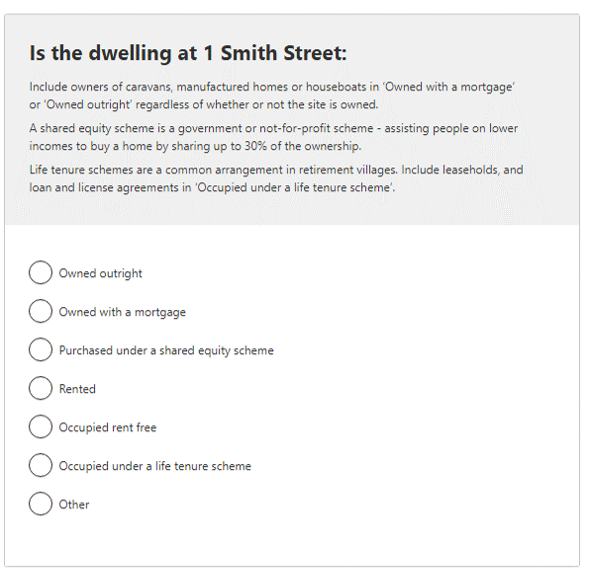Image

Description
Example
Image

Description
Example
Image

Description
Example
Image

This variable records the landlord type of rented dwellings. It applies to all occupied private dwellings that are being rented, including being occupied rent free. A private dwelling is defined in Dwelling structure (STRD) and can include caravans in caravan parks, occupied tents, and houseboats.
Rented dwellings are classified in Tenure type (TEND).
Occupied private dwellings being rented (including being occupied rent free)
| Code | Category |
|---|---|
| 10 | Real estate agent |
| 20 | State or territory housing authority |
| 21 | Community housing provider |
| 31 | Person not in the same household - parent/other relative |
| 32 | Person not in the same household - other person |
| 40 | Owner/Manager of a residential park (including caravan parks and manufactured home estates) |
| 51 | Employer – Government (includes Defence Housing Australia) |
| 52 | Employer – other employer |
| && | Not stated |
| @@ | Not applicable |
Number of categories: 10
Not applicable (@@) category comprises:
This variable is created based on responses from the Tenure type and Landlord type questions on the Census form.
Only one response can be given for this item. If respondents provide more than one response to this question in error, the first response is used.
The question about landlord type was first asked in the 1954 Census and has been included in every subsequent Census.
In 1971, the response categories increased to three: State Housing Authority; Employer; and Other landlord. The number of response categories continued to increase from three (from 1971 until 1991) to seven (in 1996 and 2001) and then to eight for subsequent censuses.
For 2021, instructional text has been added for the Community housing provider category and the response order changed to place this category closer to the top. Additionally, the following categories have been amended as follows:
| 2016 | 2021 | ||
|---|---|---|---|
| Code | Category | Code | Category |
| 60 | Housing co-operative/community/church group | 21 | Community housing provider |
| 40 | Residential park (includes caravan parks and marinas) | 40 | Owner/manager of a residential park (includes caravan parks and manufactured home estates) |
| 51 | Employer - Government (includes Defence Housing Authority) | 51 | Employer - Government (includes Defence Housing Australia) |
Landlord type allows data to be produced for studies of the socioeconomic characteristics of different tenants. It also allows for comparisons with residents in privately owned accommodation.
This data can be used with Dwelling structure (STRD) and Dwelling location (DLOD) to provide more context to the Landlord type.
The non-response rate for Landlord type (LLDD) was 0.9% in 2021. This is a decrease from 1.8% in 2016.